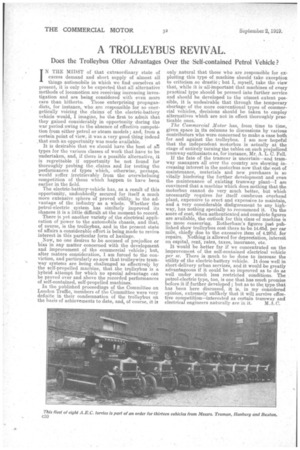A TROLLEYBUS REVIVAL.
Page 8

If you've noticed an error in this article please click here to report it so we can fix it.
Does the Trolleybus Offer Advantages Over the Self-contained Petrol Vehicle ?
IN THE MIDST of that extraordinary state of excess demand and short supply of almost all things automobile in which we find ourselves at present, it is only to be expected that all alternative methods of locomotion are receiving increasing investigation and are being considered with even more care than hitherto. Those enterprising propagandists, for instance, who are responsible for so energetically voicing the claims of the electric-battery vehicle -would, I imagine, be the first to admit that they gained considerably in opportunity during the war period owing to the absence of effective competition from either petrol or steam models; and, from a certain point of view, it was a very good thing indeed that such an opportunity was made available. '
It is desirable that we should have the best of arl types for the various classes of work that have to be undertaken, and, if there is a possible alternative, it is regrettable if opportunity be not found for thoroughly probing the claims and for testing the performances of types which, otherwise, perhaps, would suffer irretrievably from the overwhelming competition of those which happen to have been earlier in the field.
The electric-batteryvehicle has, as a result of this opportunity, undoubtedly secured for itself a much more extensive sphere .of proved utility., to the advantage of the industry as a whole. 'Whether the petrol-electric system. has similarly improved its chances it is a little difficult at the moment to record.
There is yet another variety of the electrical application of power to the ,auto.mdbile chassis, and that, of course, is the trolleybus, and in the present state of affairs a considerable effort is being made to revive interest in this particular form of haulage. Now, no one desires to be accused of prejudice or bias in any matter concerned with the development and improvement of the commercial vehicle; but, after mature consideration, 1 am forced to the conviction, and particularly so now that trolleywire tramway systems are being challenged so effectivelY by the self-propelled machine, that the trelleybus is a hybrid attempt for which no special advantage can be proved over and above the recorded performances of self-contained, self-propelled machines. In the published proceedings of the Committee on London Traffic, members of the Committee were very definite in their condemnation of the trolleybus on the basis of achievements to date, and, of course, it is
only natural that those who are responsible for exploiting this type of machine should take exception to criticism so drastic ; but I, myself, take the view that, while it is-all-important that machines of every practical type should be pressed into further service and should be developed to the utmost extent possible, it is undesirable that through the temporary shortage of the more conventional types of commercial vehicles, decisions should be taken to employ alternatives which are not in effect thoroughly practicable ones.
The Commercial Motor has, from time to time, given space in its columns to discussions by various contributors who were concerned to make a case both for and against the trolleybus. I am now hopeful that the independent motorbus is actually at the stage of entirely turning the tables on such prejudiced tramway enthusiasts as, for instance, Mr. A. L. C. Fell.
If the fate of the tramcar is uncertain—and tramway managers all over the country are showing -increasing interest in the niotorbus now that the cost of maintenance, materials and new purchases is so vitally hindering the further development and even the maintenance of existing tramway plant—I am convinced that a machine which does nothing that the motorbus cannot do very much better, but which necessarily requires for itself cumbrous overhead plant, expensive to erect and expensive to maintain, and a very considerable disfigurement to any highway, has nothing specially to recommend it. On the score of cost, when authenticated and complete figures are available, the outlook for this class of machine is no more reassuring. Rotherham's figures just published show trolleybus cost there to be 14.65d. per car mile, chiefly due to the excessive item of 4.297d. for repairs. Nothing is allowed for depreciation, intereit 'on capital, rent, rates, taxes, insurance, etc.
It would be better far if we concentrated on the improvement of the self-contained electrical vehicle per se. There is much to be done to increase the utility of the electric-battery vehicle. It does well in short-delivery urban services, and it would be greatly advantageous if it could be so improved as to do as well under much less restricted conditions. The petrol-electric type, too, is one that has much promise before it if further developed ; but as to the, type that has been here discussed, it is, in my considered opinion, extremely unlikely that it will survive effective competition—interested as certain tramway and
electrical engineers naturally are in it. M.A. C.






















